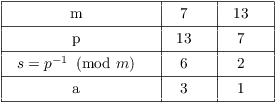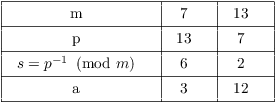In this section, we'll begin our discussion of quadratic congruences. The central result to come is called Quadratic Reciprocity.
Gauss considered the proofs he gave of quadratic reciprocity one of his crowning achievements; in fact, he gave 6 distinct proofs during his lifetime. Reciprocity is a deep result: Proofs eluded both Euler and Legendre.
The reciprocity law is simple to state. For p and q odd primes, it relates solutions to the two congruences
![]()
(Note how p and q switch places: This explains why it's called a reciprocity law.) The law of quadratic reciprocity says:
The congruences are either both solvable or both unsolvable, unless both primes are congruent to 3 mod 4. In that case, one is solvable while the other is not.
Gauss first gave a proof of this when he was 19!
Gauss's masterwork, the Disquisitiones Arithmeticae, was published in 1801 when Gauss was 24. It changed the course of number theory, collecting scattered results into a unified theory.
We'll look at some important computational devices before we consider reciprocity.
Definition. Let ![]() ,
, ![]() . a is a
quadratic residue mod m if the following equation has a
solution:
. a is a
quadratic residue mod m if the following equation has a
solution:
![]()
Otherwise, a is a quadratic nonresidue mod m.
Example. (a) Is 8 a quadratic residue mod 17?
(b) Find all the quadratic residues mod 18.
(a) 8 is a quadratic residue mod 17, since ![]() .
.![]()
(b) I list the elements in ![]() which
are relatively prime to 18 and compute their squares mod 18:
which
are relatively prime to 18 and compute their squares mod 18:

The quadratic residues are the squares: that is, 1, 7, and 13.
Since ![]() , the second row of the table is
symmetric left-to-right.
, the second row of the table is
symmetric left-to-right.![]()
Lemma. Let p be an odd prime, and consider the congruence
![]()
(a) The only solution is ![]() if
if ![]() .
.
(b) There are exactly 0 or 2 solutions if ![]() .
.
Proof. ![]() solves
solves ![]() . Conversely, if
. Conversely, if ![]() , then
, then ![]() , so
, so ![]() , and hence
, and hence ![]() .
.
Suppose ![]() . To show there are 0 or 2
solutions, suppose there is at least one solution b. Then
. To show there are 0 or 2
solutions, suppose there is at least one solution b. Then ![]() , so
, so ![]() . I
claim that b and
. I
claim that b and ![]() are distinct.
are distinct.
If not, then ![]() , so
, so ![]() . p is an odd prime, so
. p is an odd prime, so ![]() . Therefore,
. Therefore, ![]() ,
, ![]() ,
, ![]() , and
finally
, and
finally ![]() --- contradicting
--- contradicting ![]() . Hence,
. Hence, ![]() .
.
Now I have two distinct solutions; since a quadratic equation mod p
has at most two solutions (Prove it!), there are exactly two.![]()
For example, ![]() has 5 and 12 as
solutions, and
has 5 and 12 as
solutions, and ![]() .
.
On the other hand, you can check that the quadratic residues mod 17
are ![]() . Thus,
. Thus, ![]() has no solutions.
has no solutions.
Note that the result is false if ![]() , since
, since ![]() has exactly one solution:
has exactly one solution: ![]() .
.
Corollary. Let p be an odd prime. There are
![]() quadratic residues and
quadratic residues and ![]() quadratic nonresidues mod p in
quadratic nonresidues mod p in ![]() .
.
Proof. k and ![]() have the same square mod p. That is, 1 and
have the same square mod p. That is, 1 and ![]() have the same square, 2 and
have the same square, 2 and ![]() have the same square, ..., and
have the same square, ..., and ![]() and
and ![]() have
the same square.
have
the same square.
Thus, the number of different squares is ![]() --- these squares are the quadratic
residues, and the other
--- these squares are the quadratic
residues, and the other ![]() numbers
in
numbers
in ![]() are quadratic
nonresidues.
are quadratic
nonresidues.![]()
Definition. Let p be an odd prime, and let
![]() . The Legendre
symbol
. The Legendre
symbol ![]() is defined by
is defined by
![]()
Note that ![]() is disallowed (since
is disallowed (since ![]() ) even though
) even though ![]() has a solution.
has a solution.
As an easy example, ![]() ,
since
,
since ![]() . On the other hand,
. On the other hand, ![]() , because as I noted above
, because as I noted above ![]() has no solutions.
has no solutions.
You might wonder about the case where ![]() , or the case where the modulus is composite. For
, or the case where the modulus is composite. For
![]() , there are only two quadratic congruences:
, there are only two quadratic congruences:
![]()
These have the solutions ![]() and
and ![]() --- nothing much is going on.
--- nothing much is going on.
If the modulus has prime factorization ![]() , then relative primality implies
that it's enough to solve the congruences
, then relative primality implies
that it's enough to solve the congruences ![]() for each i. It turns out that
solving such a congruence reduces to determining whether a is a
quadratic residue mod
for each i. It turns out that
solving such a congruence reduces to determining whether a is a
quadratic residue mod ![]() . Therefore, there is little harm
in concentrating on the case of a single prime.
. Therefore, there is little harm
in concentrating on the case of a single prime.
Example. Solve the congruence
![]()
I'll solve the congruences
![]()
![]() reduces to
reduces to ![]() . Making a table of squares mod 7, I find
that the solutions are
. Making a table of squares mod 7, I find
that the solutions are ![]() and
and ![]() mod 7.
mod 7.
![]() reduces to
reduces to ![]() . The solutions are
. The solutions are ![]() and
and ![]() mod 13.
mod 13.
I'll consider the ![]() possibilities, solving using
the Chinese Remainder Theorem. But note that since
possibilities, solving using
the Chinese Remainder Theorem. But note that since ![]() , the solutions will come in pairs. So once
I find a solution m, I know that
, the solutions will come in pairs. So once
I find a solution m, I know that ![]() is also a solution.
is also a solution.
Consider
![]()

![]()
Then ![]() is another solution.
is another solution.
Consider
![]()

![]()
Then ![]() is another solution.
is another solution.
It's possible that the second computation might have given me 25, the
solution I got earlier. In that case, I'd have to move on to one of
the other two cases. I got lucky and had to only do two cases,
instead of three.![]()
Here are some tools for computing Legendre symbols.
Theorem. (Euler) Let p be an odd prime, ![]() ,
, ![]() . Then
. Then
![]()
Proof. There are two cases. Suppose that ![]() . Then there is a number b such that
. Then there is a number b such that ![]() . So
. So
![]()
If ![]() , then
, then ![]() , a
contradiction. So
, a
contradiction. So ![]() , and Fermat's theorem implies
that
, and Fermat's theorem implies
that ![]() . So
. So
![]()
The other possibility is ![]() . In
this case, consider the set
. In
this case, consider the set ![]() .
I claim that these integers occur in pairs s, t, such that
.
I claim that these integers occur in pairs s, t, such that ![]() .
.
First, if ![]() , then s is
invertible mod p. So I can write
, then s is
invertible mod p. So I can write ![]() , and the
pair s,
, and the
pair s, ![]() , multiplies to a.
, multiplies to a.
Moreover, s and ![]() are distinct. If not,
are distinct. If not, ![]() , or
, or ![]() , which
contradicts
, which
contradicts ![]() .
.
Since the integers ![]() divide up into
pairs, each multiplying to a, and since there are
divide up into
pairs, each multiplying to a, and since there are ![]() pairs, I have
pairs, I have
![]()
By Wilson's theorem,

Example. Use Euler's formula to compute ![]() .
.
![]()
Hence, ![]() , and
, and ![]() should have a solution. Indeed,
should have a solution. Indeed,
![]()
Euler's formula gives an expression for the Legendre symbol, but it becomes tedious to compute with it if the numbers are large. We'll see that you can use the properties of the Legendre symbol given below together with Quadratic Reciprocity to simplify computations.
Proposition. If ![]() , then
, then ![]() .
.
Proof. If ![]() , then
, then ![]() if and only if
if and only if ![]() . Thus, one of these equations is solvable
or not solvable if and only if the same is true for the other ---
which means
. Thus, one of these equations is solvable
or not solvable if and only if the same is true for the other ---
which means ![]() .
.![]()
Note that I can use this result to apply Euler's formula to ![]() for
for ![]() by simply replacing
a with
by simply replacing
a with ![]() such that
such that ![]() .
.
Proposition. Let p be an odd prime, ![]() ,
, ![]() . Then
. Then
![]()
Proof. By Euler's formula,
![]()
Therefore,
![]()
The two sides of this equation are ![]() . Since p is an odd prime, the two sides can't differ
by 2. Hence, they must be equal as integers:
. Since p is an odd prime, the two sides can't differ
by 2. Hence, they must be equal as integers:
![]()
Corollary. Let p be an odd prime, ![]() ,
, ![]() . Then
. Then
![]()
Proof.
![]()
You can use the results above to compute ![]() for specific values of a and arbitrary p.
for specific values of a and arbitrary p.
Proposition. Let p be an odd prime. Then
![]()
Proof. By Euler's formula,
![]()
![]()
As examples, ![]() ,
because
,
because ![]() . Thus,
. Thus, ![]() has solutions. And in fact,
has solutions. And in fact,
![]()
Likewise, ![]() ,
because
,
because ![]() . Hence,
. Hence, ![]() has no solutions.
has no solutions.
Using Gauss's lemma, which I'll prove shortly, you can also show that
![]()
Note that ![]() is actually an integer:
Since
is actually an integer:
Since ![]() , I have
, I have ![]() . And
. And ![]() is divisible by 8, because one of k,
is divisible by 8, because one of k, ![]() , must be even.
, must be even.
So, for example,
![]()
Therefore, ![]() has solutions.
has solutions. ![]() works, for instance.
works, for instance.
Copyright 2019 by Bruce Ikenaga